Introduction
The contribution of potato (Solanumtuberosum L.) to India’s economy is manifold. Potato has excelled as the principal crop by registering higher growth rates during the last four decades. Potato, a horticulture crop, is widely acceptable and hence provides flexibility in production. Potato plays an important role in human nutrition. It is rich source of starch, vitamin, minerals and proteins. It contains carbohydrates (81.70%), protein (8.5%), fat (0.4%), water (7.0%), ash (4.1%), and 349 calories on dry weight basis.1 The estimated area planted in India for potato in 2016-17 was 2164.10 thousand hactare and with a production of 46545.60 thousand metric tonnes. In Haryana, potato was grown in an area of 36.29 thousand hectares and production was 964.80 thousand metric tonnesduring the year 2016-17.2
The sowing operation of potato is carried out by the potato planters, but the harvesting operation is carried out manually with spade or hand hoe, which is tedious, labour intensive and time consuming. It is estimated that 700 man-h ha-1 are required for manual harvesting of the potato crop. The percentage of potato damage due to cutting action of spade or hoe is sometimes significant which reduces its market value and storability. About 10% of the tubers are cut or bruised during manual harvesting.3 There are potato diggers available in the local market and mechanical harvesting of potato saves approximately 65% and 45% of time and cost, respectively as compared to manual digging.4 There is no doubt that the use of digger will continue to extend as labour problems. Moreover, the farmers cannot afford to buy independent digger for each crop. Therefore, it was proposed to evaluate the root crop digger which was designed to dig different crops namely potato, onion, carrot, turmeric, garlic etc. This study aimed to evaluate the root crop digger for digging root crops, separating and transporting them with minimum losses, mechanical damage and cost.
Materials and Methods
The test was conducted at farmer’s field. The tests on experimental root crop digger were conducted in crop potato. A variety of potato crop for testing was Chandermukhi.
The main frame is made up of mild steel box section of 1140 x 72 mm for mounting oscillating conveyor, digging blade and power transmission unit. The digging blade is made from high carbon wear resistant steel. The length, width and thickness of the blade are 350, 1130 mm and 7.0 mm. Two coulters of high carbon steel material, diameter 500 mm and thickness 5.5 mm is mounted on both side of the digger for easy penetration in the soil. While testing, the root crop digger was installed on level ground. The machine was run at no load to ensure that each component of the digger was working properly.
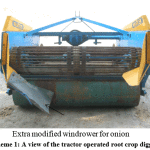 |
Scheme 1: A view of the tractor operated root crop digger. Click here to View Scheme |
An experiment was conducted according to the plan of the experiment indicated in Table 1. For each test, three replications were taken at each combination of the variables. The following performance parameters were determined to evaluate the root drop digger.9
Exposed potato
The exposed potato was calculated to know how efficiently the oscillating conveyor was able to separate the potato from soil. It was defined as follows
![]()
Where,
a is the total number of potato visible on the top surface of the soil after being digged by root crop digger
b is the total number of potato digged by the root crop digger
Undug potato
The undug potato was calculated to know how much of the potato remained undug. It was defined as follows
![]()
Where,
c is the total number of undugpotato/carrot/onion (digged manually after the operation of root crop digger)
d is the total number of potato/carrot/onion (digged and undug both)
Bruised Potato
Bruised potato required to know the percentage of bruised potato (skin comes cut) either by striking with soil clods or due to rubbing action while being conveyed on the oscillating conveyor. It was defined as follows
![]()
Where,
e is the total number of potato which are bruised
Cut Potato
Cut potato was calculated to know the percentage of potato which was cut by the digging blade. It was defined as follows
![]()
Where,
f is the total number of cut potato by the digging blade
Digging Efficiency
Digging efficiency was calculated to know how efficiently the digger worked in digging the potato/carrot/onion.
![]()
Where,
g is the total number of digged potato by the root crop digger
Table 1: Plan of experiment of root crop digger.
| Crop | Level of variables | Performance parameter |
|
Potato |
Blade angle – 170 |
1. Undug tuber |
|
200 |
2. Exposed tuber |
|
|
230 |
3. Bruised tuber |
|
|
Speed – 2.3 kmh-1 |
4. Cut tuber |
|
|
2.8 kmh-1 |
5. Digging efficiency |
|
|
3.3 kmh-1 |
Table 2: Different treatment combination for the experiment.
| Treatment combinations | |
|
T1 |
S1(2.3 kmh-1) + A1(17º) |
|
T2 |
S1(2.3 Kmh-1)+ A2(20º) |
|
T3 |
S1(2.3 kmh-1) + A3(23º) |
|
T4 |
S2 (2.8 kmh-1) + A1(17º) |
|
T5 |
S2 (2.8 kmh-1) + A2(20º) |
|
T6 |
S2(2.8 kmh-1) + A3(23º) |
|
T7 |
S3(3.3 kmh-1) + A1(17º) |
|
T8 |
S3(3.3 kmh-1) + A2(20º) |
|
T9 |
S3(3.3 kmh-1)+ A3(23º) |
Draft
The draft was measured by using the dynamometer attached between the two tractors. The digger was attached to the tractor in lowered position and kept the tractor in neutral position and this tractor was pulled by another tractor and the draft was measured. Similarly the draft was measured, when the digger was in not working condition. The difference between the two readings of the dynamometer was taken as the draft of the machine.
Field capacity and field efficiency
Field capacity and field efficiency of the machine was determined. Field capacity is the actual average rate of coverage by the machine, based upon the total field time. Field efficiency is the ratio of effective field capacity to theoretical field capacity, expressed in percent.
Cost of operation of root crop digger
The total cost of the root crop digger was determined based on fixed and variable cost. The cost of operation obtained was compared with conventional practice of digging by spade.
Statistical Analysis
In order to see the significance of results for exposed, undug, bruised, cut and digging efficiency; the data were subjected to statistical analysis at was significant at 5 per cent level of confidence by the analysis of variance programme.5
Results and Discussion
The field experiment was conducted at farmer’s field in sandy loam soil of Haryana state during the year 2011-12. During the harvesting periods of the crops, the average moisture content of soil was 12.60 per cent and average bulk density of soil was 1530 kg/m3. Results of machine harvesting of potato crop at different blade angles and forward speeds, and influence of machine variables on different crop parameters are presented in Table 4. The average value of the crop parameters at the time of digging the potato crop was shown in the table 3.
Table 3: Average (range of variation) values of various physical parameters for potato crop.
| Physical Parameters | Mean | Range |
|
Row to row spacing, cm |
40 |
– |
|
Height of ridge, cm |
15 |
– |
|
Plant to plant spacing, cm |
17.65 |
(14.50-20.50) |
|
Shoot length, cm |
80.8 |
(67.00-97.00) |
|
Depth of crop, cm |
14.4 |
(12.50-16.00) |
|
No. of roots per meter row length, cm |
95 |
(88-102) |
Optimization of Machine Variables
Exposed Potatoes
The mean values of exposed potatoes at different forward speed and blade angle are shown in Fig.1 and Table 3. From Fig. 1 and Table 3 it can be seen that as the forward speed of digger increased from 2.3 to 3.3 km h-1, the exposed potatoes increased from 93.04 to 94.98 per cent at blade angle of 170.
Table 4: Average observations on performance of root crop digger in potato crop.
| Treatment | Parameters of Potato crop | ||||
|
Exposed, % |
Undug, % |
Cut, % |
Bruised, % |
Digging efficiency, % |
|
|
T1 |
93.04 |
4.12 |
3.18 |
1.44 |
95.88 |
|
T2 |
91.77 |
3.41 |
2.75 |
2.44 |
96.59 |
|
T3 |
90.62 |
2.1 |
1.71 |
2.48 |
97.9 |
|
T4 |
94.18 |
4.9 |
4.43 |
2.28 |
95.1 |
|
T5 |
93.27 |
3.76 |
3.41 |
3.41 |
96.24 |
|
T6 |
90.9 |
3.08 |
2.27 |
3.77 |
96.92 |
|
T7 |
94.98 |
5.69 |
4.97 |
3.01 |
94.31 |
|
T8 |
94 |
4.29 |
3.6 |
3.95 |
95.71 |
|
T9 |
91.79 |
3.66 |
3.04 |
4.66 |
96.34 |
Similarly an increasing trend was observed for the exposed potatoes from 91.77 to 94.00 per cent and 90.62 to 91.79 per cent as the speed increased from 2.3 to 3.3 km h-1, at blade angle of 200 and 230, respectively.Similar trends of increase in exposed tuber with increase in forward speed of root-crop digger have been reported by Singh and Gulati6 and Yasinet al.,1. The influence of forward speed on exposed potatoes was significant at 5 per cent level of confidence. The values of exposed potatoes were non- significant for different blade angles. The interaction effect of forward speed and blade angle was also non- significant.The exposed potatoes were found to be 100 % by conventional method.
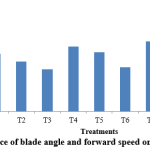 |
Figure 1: Influence of blade angle and forward speed on exposed potatoes. Click here to View Figure |
Bruised Potatoes
The values of bruised potatoes were non- significant at different blade angles and forward speed. The interaction effect of forward speed and blade angle was also non- significant. The mean values in Table 4 indicate that the minimum bruisness of 1.14 per cent was obtained at speed of 2.3 km h-1 and blade angle of 170.
Undug Potatoes
The statistical analysis of data on the influence of study variables on the undug potatoes indicated that the undug potatoes were highly influenced by blade angle at 1% level of significance and speed at 5% level of significance. But the interaction of angle and speed was non- significant.The mean values of undug potatoes at different forward speed and blade angles are shown in Fig. 2 and Table 4. From Fig.2 and Table 4, it can be seen that as the blade angle of digger increased from 170 to 200, the undug potatoes decreased from 4.12 to 3.41 per cent and further decreased to 2.10 per cent as the blade angle increased to 230 at forward speed of 2.3 km h-1. Similarly the undug potatoes decreased from 4.90 to 3.76 per cent and 5.69 to 4.29 per cent as the blade angle increased from 170 to 200 at speed 2.8 km h-1 and 3.3 km h-1, respectively. With increase in blade angle to 230, the undug potatoes decreased to 3.08 and 3.66 per cent at speeds of 2.8 km h-1 and 3.0 km h-1.
From Fig. 2 and Table 4, it can also be seen that as the forward speed of digger increased from 2.3 to 2.8 km h-1, the undug potatoes increased from 4.12 to 4.90 per cent and further increased to 5.69 as speed increased to 3.3 km h-1 at blade angle of 170. Similarly the undug potatoes showed an increasing trend from 3.41 to 4.29 per cent and 2.10 to 3.66 per cent as speed increased from 2.3 to 3.3 km h-1 at blade angle of 200 and 230, respectively.There were no undug potatoes left by conventional method.
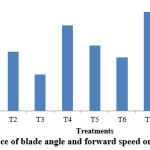 |
Figure 2: Influence of blade angle and forward speed on undug potatoes. Click here to View Figure |
Cut Potatoes
The influence of forward speed on cut potatoes was significant at 1 per cent level of confidence. The effect of blade angle was also significant at 1 per cent level of confidence. The interaction effect of forward speed and blade angle was non- significant.
The mean values of cut potatoes at different forward speed and blade angle are shown in Fig. 3 and Table 4. From Fig. 3 and Table 4, it can be seen that as the forward speed of digger increased from 2.3 to 3.3 km h-1, the cut potatoes showed increasing values ranging from 3.18 to 4.97 per cent at blade angle of 170. Similarly the cut potatoes increased from 2.75 to 3.60 per cent and 1.71 to 3.04 per cent as the forward speed of digger increased from 2.3 to 3.3 km h-1, at blade angle of 200 and 230, respectively. Similar trends of increase in cut-potatoes with increase in forward speed of root-crop digger have been reported by Sharma and Verma7 and Ibrahim etal.,8. From Fig. 3 and Table 4, it can also be seen that as the blade angle of digger increased from 170 to 230, the cut potatoes decreased from 3.18 to 1.71 per cent at forward speed of 2.3 km h-1. Similarly the cut potatoes decreased from 4.43 to 2.27 per cent and 4.97 to 3.04 as blade angle increased for 170 to 230, at forward speed of 2.8 km h-1 and 3.3 km h-1, respectively.The cut potatoes were found to be 8.15 % by conventional method.
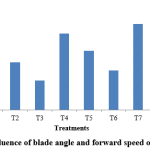 |
Figure 3: Influence of blade angle and forward speed on cut potatoes. Click here to View Figure |
Digging Efficiency
The influence of forward speed and blade angle on digging efficiency was significant at 5 per cent level of confidence. The values of digging efficiency were non-significant for interaction of speed and blade angles. The mean values of digging efficiency at different forward speed and blade angle are shown in Fig. 4 and Table 4. From Fig. 4 and Table 4, it can be seen that as the forward speed of digger increased from 2.3 to 3.3 km h-1, the digging efficiency decreased from 95. 88 to 94.31 per cent at blade angle of 170. Similarly the digging efficiency decreased from 96.59 to 95.71 per cent and 97.90 to 96.34 per cent as the forward speed of digger increased from 2.3 to 3.3 km h-1, at blade angle of 200 and 230, respectively.
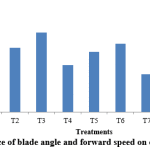 |
Figure 4: Influence of blade angle and forward speed on digging efficiency. Click here to View Figure |
From Fig. 4 and Table 4, it can also be seen that as the blade angle of digger increased from 170 to 230, the digging efficiency increased from 95.88 to 97.90 per cent at forward speed of 2.3 km h-1. Similarly the digging efficiency increased from 95.10 to 96.92 per cent and 94.31 to 96.34 as blade angle increased from 170 to 230, at speed of 2.8 km h-1 and 3.3 km h-1, respectively. The digging efficiency was found to be 100 % by conventional method.
Draft
The draft of the root crop digger at blade angle 170, 200 and 230 was 1000, 1050, and 1110kgf, respectively. The field capacity and the field efficiency of root crop digger wereobtained 0.21ha h-1 and 65 %, respectively. The fuel consumption was found to be 4.75l h-1.
Cost of Operation
The operating cost of digging by both the methods i.e. digging by root crop digger and digging by conventional was Rs. 2241.16 and 15625 per hectare, respectively. The saving in cost of digging by root crop digger was Rs. 8384 per hectare. Decrease in cost of digging by root crop digger was found to be 54 per cent in comparison to conventional method.
Optimized values of blade angle and forward speed for potato crop
The treatment T3 may be considered as best optimized value for performance of the root crop digger for potato i.e., forward speed 2.3 km h-1 and blade angle 230.
Conclusion
The per cent of exposed potatoes, undug potatoes and cut potatoes increased with increase in forward speed of root crop digger but the digging efficiency decreased with increase in speed. The per cent of exposed potatoes, undug potatoes, cut potatoes decreased with increase in blade angle of root crop digger. But the digging efficiency increased with increase in blade angle of root crop digger. So, the above study revealed that the forward speed 2.3 km h-1 and blade angle of 230 is selected best for operation of the digger in the field for potato crop.
Acknowledgments
The author is thankful to the Department of Farm Machinery and power engineering, Chaudhary Charan Singh Haryana Agricultural University, Hisar, Haryana for all kind of assistance and ICAR for the funding assistance throughout the experimentation.
Conflict of Interest
Authors declare no conflict of interest.
References
- Pushkarnath. Problem of potato varieties in India. Expl. Agric, 1970;6: 181-190.
CrossRef - Mamta Saxena. Horticulture statistics at a glance 2017. National Horticulture Board, Ministry of Agriculture and Farmers Welfare, Government of India, Gurugram – 122015 (Haryana).2017. 1-514. http://www.nhb.gov.in. 14th September. 10th August.
- Yasin M., Ahmed M. M., Rehman R. Design, development and performance evaluation of rotary potato digger. Agricultural Mechanization in Asia, Africa and LatinAmerica, 2003; 34 (2): 43-46.
- Hamid T. Evaluation of rotary potato digger. Unpublished M.Sc. Thesis. University of Agriculture Faisalabad, Pakistan, 1997.
- Sheoran O.P., Tonk D. S., Kaushik L. S., Hasija R. C., Pannu R. S. Statistical Software Package for Agricultural Research Workers. Department of Mathematics and Statistics, CCS HAU, Hisar, 1998.
- Singh Manjit and Gulati Sunil. Design and development of an oscillating type potato digger. Potato, global research and development, 2002; 2: 989-992.
- Sharma A. P., Verma S. R. Performance and vibration of tractor mounted oscillatory potato digger, Agricultural Mechanization in Asia, Africa and LatinAmerica, 1986;17(1): 47-51.
- Ibrahim M. M., Amin E., Farag A. Developing a multipurpose digger for harvesting root crop digger. Misr J. Ag. Eng, 2008; 25(4): 1225-1239.
- IS 13818 (1993): Harvesting equipment – Tractor operated potato digger shakers – Test code, FAD 21: Farm Implements and Machinery.


